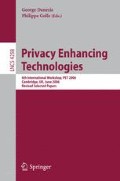Abstract
Key-tree based private authentication has been proposed by Molnar and Wagner as a neat way to efficiently solve the problem of privacy preserving authentication based on symmetric key cryptography. However, in the key-tree based approach, the level of privacy provided by the system to its members may decrease considerably if some members are compromised. In this paper, we analyze this problem, and show that careful design of the tree can help to minimize this loss of privacy. First, we introduce a benchmark metric for measuring the resistance of the system to a single compromised member. This metric is based on the well-known concept of anonymity sets. Then, we show how the parameters of the key-tree should be chosen in order to maximize the system’s resistance to single member compromise under some constraints on the authentication delay. In the general case, when any member can be compromised, we give a lower bound on the level of privacy provided by the system. We also present some simulation results that show that this lower bound is quite sharp. The results of this paper can be directly used by system designers to construct optimal key-trees in practice; indeed, we consider this as the main contribution of our work.
Access this chapter
Tax calculation will be finalised at checkout
Purchases are for personal use only
Preview
Unable to display preview. Download preview PDF.
References
Avoine, G., Dysli, E., Oechslin, P.: Reducing time complexity in RFID systems. In: Preneel, B., Tavares, S. (eds.) SAC 2005. LNCS, vol. 3897, Springer, Heidelberg (2006)
Boyd, C., Mathuria, A.: Protocols for Authentication and Key Establishment. Springer, Heidelberg (2003)
Camenisch, J., Lysyanskaya, A.: A Efficient Non-transferable Anonymous Multi-show Credential System with Optional Anonymity Revocation. In: Pfitzmann, B. (ed.) EUROCRYPT 2001. LNCS, vol. 2045, Springer, Heidelberg (2001)
Chaum, D.: The Dining Cryptographers Problem: Unconditional sender and recipient untraceability. Journal of Cryptology 1(1), 65–75 (1988)
Díaz, C., Seys, S., Claessens, J., Preneel, B.: Towards measuring anonymity. In: Dingledine, R., Syverson, P.F. (eds.) PET 2002. LNCS, vol. 2482, pp. 54–68. Springer, Heidelberg (2003)
Elektra Hungaria (In Hungarian), http://www.gkm.gov.hu/data/357863/kovetelmeny1215.pdf
IKE, The Internet Key Exchange, RFC 2409, http://www.ietf.org/rfc/rfc2409.txt
ISO 9798-2. Mechanisms using symmetric encipherment algorithms, http://www.iso.org
Juels, A.: RFID security and privacy: a research survey. manuscript, condensed version will appear in the IEEE Journal on Selected Areas in Communication (September 2005)
Kerberos. RFC 1510, http://www.ietf.org/rfc/rfc1510.txt
Molnar, D., Wagner, D.: Privacy and security in library RFID: issues, practices, and architectures. In: Proceedings of the ACM Conference on Computer and Communications Security (2004)
Nohara, Y., Inoue, S., Baba, K., Yasuura, H.: Quantitative Evaluation of Unlinkable ID Matching Schemes. In: Workshop on Privacy in the Electronic Society, WPES (2005)
Pfitzmann, A., Köhntopp, M.: Anonymity, unobservability and pseudonymity – a proposal for terminology. In: Federrath, H. (ed.) Designing Privacy Enhancing Technologies. LNCS, vol. 2009, pp. 1–9. Springer, Heidelberg (2001)
Serjantov, A., Danezis, G.: Towards an information theoretic metric for anonymity. In: Proceedings of the Privacy Enhancing Technologies (PET) Workshop. LNCS, Springer, Heidelberg (2002)
Author information
Authors and Affiliations
Editor information
Editors and Affiliations
Rights and permissions
Copyright information
© 2006 Springer-Verlag Berlin Heidelberg
About this paper
Cite this paper
Buttyán, L., Holczer, T., Vajda, I. (2006). Optimal Key-Trees for Tree-Based Private Authentication. In: Danezis, G., Golle, P. (eds) Privacy Enhancing Technologies. PET 2006. Lecture Notes in Computer Science, vol 4258. Springer, Berlin, Heidelberg. https://doi.org/10.1007/11957454_19
Download citation
DOI: https://doi.org/10.1007/11957454_19
Publisher Name: Springer, Berlin, Heidelberg
Print ISBN: 978-3-540-68790-0
Online ISBN: 978-3-540-68793-1
eBook Packages: Computer ScienceComputer Science (R0)

